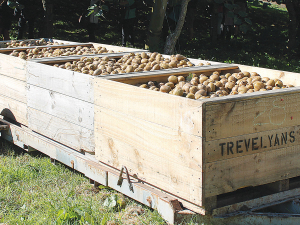Rabobank 2026 Outlook: Geopolitics shapes global agriculture
The global agricultural landscape has entered a new phase where geopolitics – not only traditional market forces – will dictate agricultural trade flows, prices, and production decisions.
 New Zealand kiwifruit exports play a vital role in ensuring year-round supply of the fruit to the US market.
New Zealand kiwifruit exports play a vital role in ensuring year-round supply of the fruit to the US market.
The US could be a growth market for New Zealand kiwifruit exporters, says a Rabobank expert.
But consumers will need ‘educating’ and value-added products will be needed to make the most of this opportunity, says RaboResearch senior analyst Roland Fumasi.
While kiwifruit is not yet a “big deal” in the US market, demand is moving in the right direction, Fumasi told kiwifruit growers via a webinar.
“At 0.25kg per person each year, kiwifruit consumption in the US falls a long way behind some of the more popular fruits like strawberries, which are close to 4kg per capita each year,” he said.
“However, we have seen good growth in kiwifruit consumption in recent years and it is now one of the more rapidly growing products in the US fruit and nut space.”
Fumasi reckons the healthfulness of kiwifruit is “off the charts” and explains growing demand over recent years, particularly in households with more disposable income.
“We’ve also seen good growth in sales of gold kiwifruit, with the sweeter flavour proving a hit with many consumers. Another factor in its popularity is it’s more ready to eat when you buy it and provides a more consistent eating experience,” he said.
“Another factor in growing demand is that the product is supplied to the US market 52 weeks of the year, which helps consumers to establish a regular consumption pattern.”
Fumasi says NZ kiwifruit exports played a vital role in ensuring year-round supply to the US market and that the high quality of our kiwifruit had helped establish a price for it.
“During the early and late months of the year, the US market is reliant on domestic kiwifruit which comes almost exclusively from California, and kiwifruit from Italy. But from April to October the market is dominated by fruit supplied by NZ and Chile.
“After losing some ground in 2012 and 2013, we’ve seen sales of NZ kiwifruit into the US trending upward and, during this period, NZ product has been able to maintain a clear price premium over kiwifruit sourced from elsewhere.”
He says consistency of eating experience has been a challenge for kiwifruit over the years.
“The gold cultivar helps, because it provides more consistency. However, I think more education is required to improve US consumer understanding of when a kiwifruit is ripe to eat and to highlight all of its great health benefits.
“I like the idea of point of purchase education because it captures the consumer’s attention right there when they’re thinking kiwifruit and gets US customers cutting into a kiwifruit when it’s ready to eat.”
He concedes that kiwifruit is not as convenient as some of the fruit it competes against, like blueberries or blackberries.
“To the younger generation, especially those who always have a mobile device in one hand, it’s a lot easier to throw a couple of blueberries in your mouth than to
scoop kiwifruit with a spoon.”
The industry should think about what value-added opportunities are available that could add convenience.
Organic potential
Despite lower growth in US organic food sales in recent years, Fumasi says the organic market is another area which shows great growth potential for NZ kiwifruit.
“Whilst surpassing US$46 billion of sales in 2018, growth in retail value of organic food sales in the US has moderated to 6% over the past two years, in comparison to 10% between 2010 and 2016,” he said.
“However, I still see plenty of potential for increased sales of organic kiwifruit as the reported volumes of organic kiwifruit are currently really low and increased supply in the short run will not outstrip demand.”
Government plans to get rid of regional councillors shows a lack of understanding of the fundamental problem affecting all of local government - poor governance.
It’s official, lamb will take centre stage on Kiwi Christmas tables this year.
For over 20 years, Whakatane farmer Gerard Van Beek has been attending Fonterra annual general meetings with the same message - it's time to include lactose in the co-op's farmgate milk price model.
Retiring Fonterra director Andy Macfarlane believes the co-operative has made good progress over the past decade but adds that there's still a way to go.
Visiting US climate change expert Dr Will Happer says the idea of reducing cow numbers to greatly reduce methane emissions is crazy.
Federated Farmers has launched a new campaign, swapping "The Twelve Days of Christmas" for "The Twelve Pests of Christmas" in an effort to highlight the most troublesome farm pests.

OPINION: Your old mate welcomes the proposed changes to local government but notes it drew responses that ranged from the reasonable…
OPINION: A press release from the oxygen thieves running the hot air symposium on climate change, known as COP30, grabbed your…